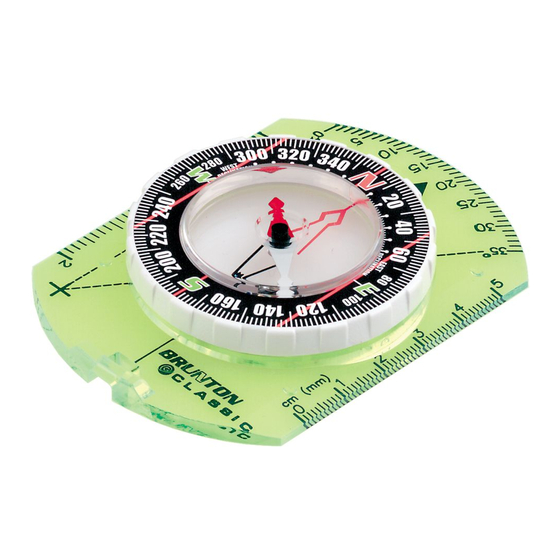
Advertisement
Table of Contents
Made
Made
Made in in in in U.S.A.
Made
U.S.A.
U.S.A.
U.S.A.
Basic
Compass
Basic
Basic
Basic Compass
Compass
Compass Facts
The magnetic compass has been used as a direction-finding device
for thousands of years, ever since it was discovered that a
magnetized needle will point in a constant direction when left free to
rotate.
This is so because the earth is surrounded by a magnetic field, and
a magnetized object will orient itself to that field, given the
opportunity.
Specifically, it will align itself so that it points toward the earth's North
magnetic pole, The North magnetic pole is located near (but not
precisely at) the geographic North pole.
Primitive compasses consisted of an iron needle which had been
stroked with a magnetic rock and then suspended from a thread, or
struck though a piece of cork or wax and placed in a bowl of water.
Although these compasses were not very precise, they nonetheless
helped early explorers and navigators find their way from one point
on the earth's surface to another, by providing a constant direction
indicator.
Today's compasses work on the same principle, nut are far more
sophisticated. In addition to a freely turning magnetic needle, a
modern, high-quality compass will have a movable, calibrated dial
and a sighting system for use in obtaining accurate bearings. More
advanced compasses can also be adjusted to compensate for the
fact that the earth's magnetic poles are not located precisely at the
geographical poles. (The error caused by this difference is called
declination , and it varies depending upon your location.)
Facts
Facts
Facts
The Brunton line of sportsman's compasses incorporates many
features first developed on our professional-grade instruments; they
are the finest popular-usage compasses available today.
Getting
Getting to to to to Know
Getting
Know
Know
Getting
Know Your
Your Brunton sportsman's compass has numerous features which
make it easy to work with and increase its usefulness. Take a few
moments to study your compass, referring to the appropriate
diagram (below) and you will be able to understand the following
instructions with little or no difficulty.
Taking a a a a Bearing
Taking
Taking
Taking
A bearing is the degree reading or direction from your position to
another object. Thus, if you were in the field and a mountain peak
was directly East of your position, the bearing of the mountain would
be 90°. If the peak were directly South, its bearing would be 270°.
(The term azimuth is sometimes used instead of bearing.)
To take a bearing hold the compass level in front of you. The
sighting line should be pointing toward the object on which you are
taking a bearing. (Fig. 2). With the sighting line pointing straight to
the object, carefully turn the dial until the orienting arrow and the
magnetic needle are lined up (Fig. 2A).
Your
Your
Brunton
Brunton
Compass
Compass
Your Brunton
Brunton Compass
Compass
Bearing
Bearing
Bearing
Advertisement
Table of Contents

Summary of Contents for Brunton 9020
- Page 1 The Brunton line of sportsman’s compasses incorporates many features first developed on our professional-grade instruments; they are the finest popular-usage compasses available today. Getting Getting Getting to to to to Know Know Know Your Your Brunton Brunton Compass Compass Getting...
- Page 2 Declination Declination Adjusting Adjusting for for Declination Declination Before using your Brunton compass, it is advisable to make sure it is properly adjusted to compensate for the local angle of declination. What What is is is is Declination? Declination? What...
- Page 3 If you are East of the zero declination line, your compass will point West of true North, This is called westerly declination. If you are West of the zero declination line, your compass will point East of true North (easterly declination). For example, in Texas, at the 8° declination line, your compass magnetic needle would point 8°...
- Page 4 Figure 6 illustrates how terrain is shown on a topographic map. Drawing Drawing Drawing Drawing Magnetic Magnetic Magnetic Magnetic North North North North Lines Lines Lines Lines on on Your Your Your Your Map. Map. Map. Map. Topographic maps have a diagram showing the magnetic declination angle. One method of constructing magnetic lines is simply extend the magnetic arrow on the map with a straight edge, Then we use the extended line as a reference to draw parallel lines at about one-inch intervals.
















Need help?
Do you have a question about the 9020 and is the answer not in the manual?
Questions and answers